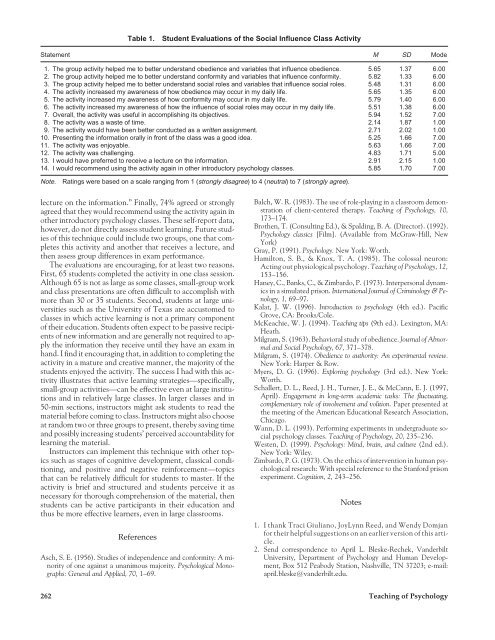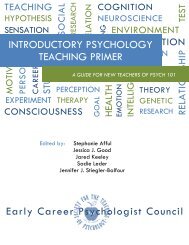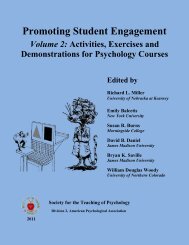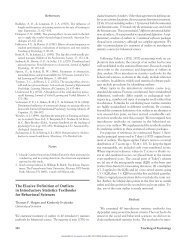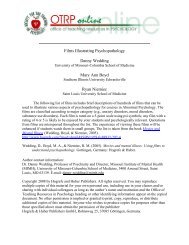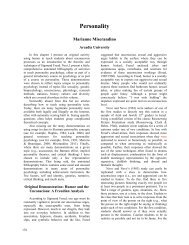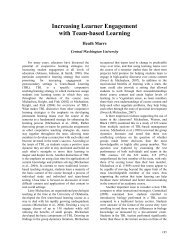Obedience, Conformity, and Social Roles: Active Learning in a ...
Obedience, Conformity, and Social Roles: Active Learning in a ...
Obedience, Conformity, and Social Roles: Active Learning in a ...
Create successful ePaper yourself
Turn your PDF publications into a flip-book with our unique Google optimized e-Paper software.
Table 1. Student Evaluations of the <strong>Social</strong> Influence Class Activity<br />
Statement M SD Mode<br />
1. The group activity helped me to better underst<strong>and</strong> obedience <strong>and</strong> variables that <strong>in</strong>fluence obedience. 5.65 1.37 6.00<br />
2. The group activity helped me to better underst<strong>and</strong> conformity <strong>and</strong> variables that <strong>in</strong>fluence conformity. 5.82 1.33 6.00<br />
3. The group activity helped me to better underst<strong>and</strong> social roles <strong>and</strong> variables that <strong>in</strong>fluence social roles. 5.48 1.31 6.00<br />
4. The activity <strong>in</strong>creased my awareness of how obedience may occur <strong>in</strong> my daily life. 5.65 1.35 6.00<br />
5. The activity <strong>in</strong>creased my awareness of how conformity may occur <strong>in</strong> my daily life. 5.79 1.40 6.00<br />
6. The activity <strong>in</strong>creased my awareness of how the <strong>in</strong>fluence of social roles may occur <strong>in</strong> my daily life. 5.51 1.38 6.00<br />
7. Overall, the activity was useful <strong>in</strong> accomplish<strong>in</strong>g its objectives. 5.94 1.52 7.00<br />
8. The activity was a waste of time. 2.14 1.87 1.00<br />
9. The activity would have been better conducted as a written assignment. 2.71 2.02 1.00<br />
10. Present<strong>in</strong>g the <strong>in</strong>formation orally <strong>in</strong> front of the class was a good idea. 5.25 1.66 7.00<br />
11. The activity was enjoyable. 5.63 1.66 7.00<br />
12. The activity was challeng<strong>in</strong>g. 4.83 1.71 5.00<br />
13. I would have preferred to receive a lecture on the <strong>in</strong>formation. 2.91 2.15 1.00<br />
14. I would recommend us<strong>in</strong>g the activity aga<strong>in</strong> <strong>in</strong> other <strong>in</strong>troductory psychology classes. 5.85 1.70 7.00<br />
Note. Rat<strong>in</strong>gs were based on a scale rang<strong>in</strong>g from 1 (strongly disagree) to 4 (neutral) to 7 (strongly agree).<br />
lecture on the <strong>in</strong>formation.” F<strong>in</strong>ally, 74% agreed or strongly<br />
agreed that they would recommend us<strong>in</strong>g the activity aga<strong>in</strong> <strong>in</strong><br />
other <strong>in</strong>troductory psychology classes. These self-report data,<br />
however, do not directly assess student learn<strong>in</strong>g. Future studies<br />
of this technique could <strong>in</strong>clude two groups, one that completes<br />
this activity <strong>and</strong> another that receives a lecture, <strong>and</strong><br />
then assess group differences <strong>in</strong> exam performance.<br />
The evaluations are encourag<strong>in</strong>g, for at least two reasons.<br />
First, 65 students completed the activity <strong>in</strong> one class session.<br />
Although 65 is not as large as some classes, small-group work<br />
<strong>and</strong> class presentations are often difficult to accomplish with<br />
more than 30 or 35 students. Second, students at large universities<br />
such as the University of Texas are accustomed to<br />
classes <strong>in</strong> which active learn<strong>in</strong>g is not a primary component<br />
of their education. Students often expect to be passive recipients<br />
of new <strong>in</strong>formation <strong>and</strong> are generally not required to apply<br />
the <strong>in</strong>formation they receive until they have an exam <strong>in</strong><br />
h<strong>and</strong>. I f<strong>in</strong>d it encourag<strong>in</strong>g that, <strong>in</strong> addition to complet<strong>in</strong>g the<br />
activity <strong>in</strong> a mature <strong>and</strong> creative manner, the majority of the<br />
students enjoyed the activity. The success I had with this activity<br />
illustrates that active learn<strong>in</strong>g strategies—specifically,<br />
small-group activities—can be effective even at large <strong>in</strong>stitutions<br />
<strong>and</strong> <strong>in</strong> relatively large classes. In larger classes <strong>and</strong> <strong>in</strong><br />
50-m<strong>in</strong> sections, <strong>in</strong>structors might ask students to read the<br />
material before com<strong>in</strong>g to class. Instructors might also choose<br />
at r<strong>and</strong>om two or three groups to present, thereby sav<strong>in</strong>g time<br />
<strong>and</strong> possibly <strong>in</strong>creas<strong>in</strong>g students’ perceived accountability for<br />
learn<strong>in</strong>g the material.<br />
Instructors can implement this technique with other topics<br />
such as stages of cognitive development, classical condition<strong>in</strong>g,<br />
<strong>and</strong> positive <strong>and</strong> negative re<strong>in</strong>forcement—topics<br />
that can be relatively difficult for students to master. If the<br />
activity is brief <strong>and</strong> structured <strong>and</strong> students perceive it as<br />
necessary for thorough comprehension of the material, then<br />
students can be active participants <strong>in</strong> their education <strong>and</strong><br />
thus be more effective learners, even <strong>in</strong> large classrooms.<br />
References<br />
Asch, S. E. (1956). Studies of <strong>in</strong>dependence <strong>and</strong> conformity: A m<strong>in</strong>ority<br />
of one aga<strong>in</strong>st a unanimous majority. Psychological Monographs:<br />
General <strong>and</strong> Applied, 70, 1–69.<br />
Balch, W. R. (1983). The use of role-play<strong>in</strong>g <strong>in</strong> a classroom demonstration<br />
of client-centered therapy. Teach<strong>in</strong>g of Psychology, 10,<br />
173–174.<br />
Brothen, T. (Consult<strong>in</strong>g Ed.), & Spald<strong>in</strong>g, B. A. (Director). (1992).<br />
Psychology classics [Film]. (Available from McGraw-Hill, New<br />
York)<br />
Gray, P. (1991). Psychology. New York: Worth.<br />
Hamilton, S. B., & Knox, T. A. (1985). The colossal neuron:<br />
Act<strong>in</strong>g out physiological psychology. Teach<strong>in</strong>g of Psychology, 12,<br />
153–156.<br />
Haney, C., Banks, C., & Zimbardo, P. (1973). Interpersonal dynamics<br />
<strong>in</strong> a simulated prison. International Journal of Crim<strong>in</strong>ology & Penology,<br />
1, 69–97.<br />
Kalat, J. W. (1996). Introduction to psychology (4th ed.). Pacific<br />
Grove, CA: Brooks/Cole.<br />
McKeachie, W. J. (1994). Teach<strong>in</strong>g tips (9th ed.). Lex<strong>in</strong>gton, MA:<br />
Heath.<br />
Milgram, S. (1963). Behavioral study of obedience. Journal of Abnormal<br />
<strong>and</strong> <strong>Social</strong> Psychology, 67, 371–378.<br />
Milgram, S. (1974). <strong>Obedience</strong> to authority: An experimental review.<br />
New York: Harper & Row.<br />
Myers, D. G. (1996). Explor<strong>in</strong>g psychology (3rd ed.). New York:<br />
Worth.<br />
Schallert, D. L., Reed, J. H., Turner, J. E., & McCann, E. J. (1997,<br />
April). Engagement <strong>in</strong> long-term academic tasks: The fluctuat<strong>in</strong>g,<br />
complementary role of <strong>in</strong>volvement <strong>and</strong> volition. Paper presented at<br />
the meet<strong>in</strong>g of the American Educational Research Association,<br />
Chicago.<br />
Wann, D. L. (1993). Perform<strong>in</strong>g experiments <strong>in</strong> undergraduate social<br />
psychology classes. Teach<strong>in</strong>g of Psychology, 20, 235–236.<br />
Westen, D. (1999). Psychology: M<strong>in</strong>d, bra<strong>in</strong>, <strong>and</strong> culture (2nd ed.).<br />
New York: Wiley.<br />
Zimbardo, P. G. (1973). On the ethics of <strong>in</strong>tervention <strong>in</strong> human psychological<br />
research: With special reference to the Stanford prison<br />
experiment. Cognition, 2, 243–256.<br />
Notes<br />
1. I thank Traci Giuliano, JoyLynn Reed, <strong>and</strong> Wendy Domjan<br />
for their helpful suggestions on an earlier version of this article.<br />
2. Send correspondence to April L. Bleske-Rechek, V<strong>and</strong>erbilt<br />
University, Department of Psychology <strong>and</strong> Human Development,<br />
Box 512 Peabody Station, Nashville, TN 37203; e-mail:<br />
april.bleske@v<strong>and</strong>erbilt.edu.<br />
262 Teach<strong>in</strong>g of Psychology


